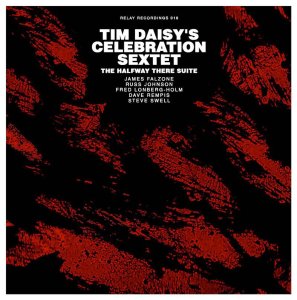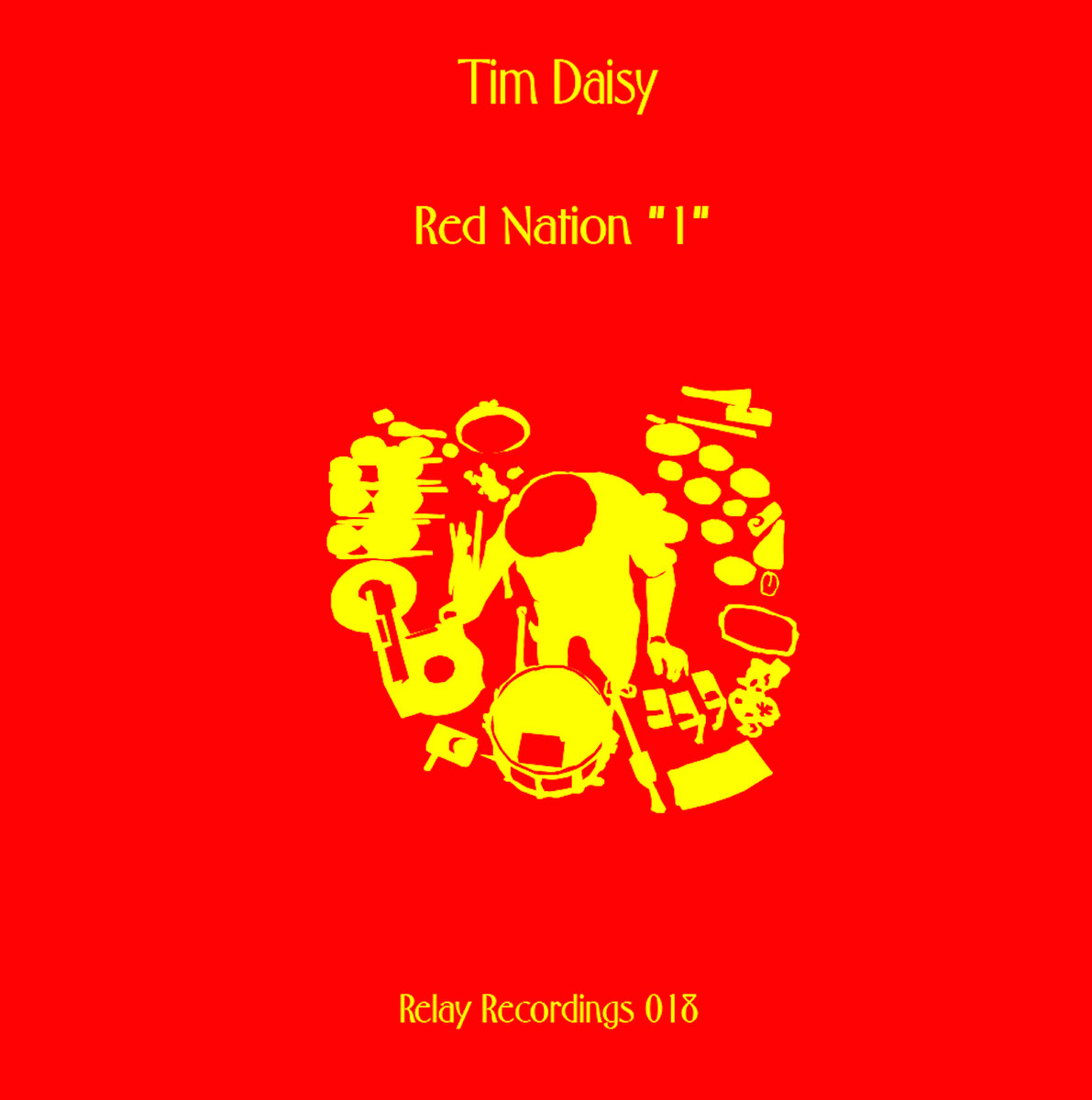Being forty years old is a curious point in an artist’s — or nearly anyone’s — life. Given the advances in modern medicine, it’s just about halfway (on average) to departure and feels like one should have passed through at least one needle’s eye, though it is far from laurel-resting territory. One is neither a young lion nor an old head. Percussionist Tim Daisy turned 40 on July 15, 2016 and, while a mainstay of the Chicago improvised music scene for fifteen-plus years, his copious and varied recordings show a dedication to organizing sound well beyond the drum kit that’s still evolving.
 Speaking of 40 being a midpoint in one’s life, Daisy convened just such a program of music for his milestone birthday last year. The Halfway There Suite consists of four movements performed by the Celebration Sextet, joining Daisy’s drums with the cello of Fred Lonberg-Holm, Dave Rempis on tenor, James Falzone on clarinet, Russ Johnson on trumpet and Steve Swell on trombone (the band is now called the Fulcrum Ensemble). Following a lilting overture and a brash, unaccompanied trombone solo, the sextet erupts into a socking swing, and it’s a joy to hear Falzone’s sharp warble propelled by Daisy’s floes and Lonberg-Holm’s deep pizzicato, before coruscating tenor shimmies direct the sextet into raucous collectivity. Under the drummer’s direction a balance is struck between chamber measurement and muscular ebullience that teeters in the most arresting instances. The fourth movement, slyly knotty and explosive, shows that Daisy is adept at composing tough, progressive jazz in addition to being an inquisitive conceptualist.
Speaking of 40 being a midpoint in one’s life, Daisy convened just such a program of music for his milestone birthday last year. The Halfway There Suite consists of four movements performed by the Celebration Sextet, joining Daisy’s drums with the cello of Fred Lonberg-Holm, Dave Rempis on tenor, James Falzone on clarinet, Russ Johnson on trumpet and Steve Swell on trombone (the band is now called the Fulcrum Ensemble). Following a lilting overture and a brash, unaccompanied trombone solo, the sextet erupts into a socking swing, and it’s a joy to hear Falzone’s sharp warble propelled by Daisy’s floes and Lonberg-Holm’s deep pizzicato, before coruscating tenor shimmies direct the sextet into raucous collectivity. Under the drummer’s direction a balance is struck between chamber measurement and muscular ebullience that teeters in the most arresting instances. The fourth movement, slyly knotty and explosive, shows that Daisy is adept at composing tough, progressive jazz in addition to being an inquisitive conceptualist.
Red Nation is Daisy’s solo project, which involves radios, turntables, contact mikes, cymbals and drum kit, sometimes spread in a semicircle on the floor, at other times employing a standard jazz drummer’s setup in conjunction with loops and overlays. At times this music veers in a direction partly offered by “post-rock” heroes, blending rubbery rim shots and fluid breaks with trance-like repetitive grind like a fuzzed-out harmonium (“Shadows Play”), at others a processional wobbles behind a gauzy, glitch-heavy veneer (“Concord Citizen”). The fondness for the crackliest of records and the superimposition of pops and surface grit along with stuck chords and distant piano glint onto cracking, diffuse funk is a curious approach. “Beats for an Owl” supplants limber over-and-under dances with organ burble and droning fuzz in doomy stasis, closing with a reverberant skip. It’s quite easy to imagine this music being fleshed out in future ensemble projects, but Red Nation stands perfectly well on its own.
 October Music Volume 2 is the latest installment in Daisy’s duets with significant Chicago improvisers, in this case Lonberg-Holm, Johnson, saxophonist Mars Williams, bassist Clark Sommers, drummer Ryan Packard, electronic musician Aaron Zarzutzki and guitarist Andrew Clinkman. “Radiant” is a chugging mass of warped, distorted guitar that periodically hangs against a bright, martial charge while “Type M” utilizes gongs, fans, and little instruments interspersed with howling soprano and drum kit. “Tandem” is a fine trumpet-percussion duo, condensed bebop imagery becoming hushed and fragmentary, poised gulps and patter eventually leaping toward throaty resonance. “Wires and Static” sets analog synthesizer and Daisy’s turntables and metronome into a dance, grungy loops augmented by rattle and quiver, and the set closes with a fine, dribbly marimba-bass conversation that sidesteps into patchy drones. There is a constant in the role of the percussionist as instigator, but these dialogues also serve to showcase a wide array of contemporary Chicago improvisation.
October Music Volume 2 is the latest installment in Daisy’s duets with significant Chicago improvisers, in this case Lonberg-Holm, Johnson, saxophonist Mars Williams, bassist Clark Sommers, drummer Ryan Packard, electronic musician Aaron Zarzutzki and guitarist Andrew Clinkman. “Radiant” is a chugging mass of warped, distorted guitar that periodically hangs against a bright, martial charge while “Type M” utilizes gongs, fans, and little instruments interspersed with howling soprano and drum kit. “Tandem” is a fine trumpet-percussion duo, condensed bebop imagery becoming hushed and fragmentary, poised gulps and patter eventually leaping toward throaty resonance. “Wires and Static” sets analog synthesizer and Daisy’s turntables and metronome into a dance, grungy loops augmented by rattle and quiver, and the set closes with a fine, dribbly marimba-bass conversation that sidesteps into patchy drones. There is a constant in the role of the percussionist as instigator, but these dialogues also serve to showcase a wide array of contemporary Chicago improvisation.
 Sounds in a Garden joins Daisy and Dutch electric bassist/guitarist Jasper Stadhouders with trombonist Wolter Wierbos (ICP Orchestra) for a set of five improvisations. The bassist and drummer are both part of reedist Ken Vandermark’s quartet Made To Break, also featuring electronic musician Christof Kurzmann, and it’s fair to say that Daisy got his biggest early lift from occupying the drum chair in Vandermark’s long-running quintet (the V5). Wierbos is a garrulous chortler, albeit tasteful in his regular application of whimsy. Malleted rings and low jolts of feedback flesh out sparser sections, and occasionally the trombonist grants laid-back poise to Stadhouders’ jittery, muted wire. Brass and amplified strings offer a fine example of subtle foreground and background role-reversal, with Daisy shimmering and nudging around them. Occasionally, the trio drifts into subversive play, bent long tones, prerecorded radio chatter and wild vocal multiphonics refereed in proximal disconnect, though rugged triangulation is more often the group’s mettle. This is an excellent trio that hopefully will continue exploring its identity.
Sounds in a Garden joins Daisy and Dutch electric bassist/guitarist Jasper Stadhouders with trombonist Wolter Wierbos (ICP Orchestra) for a set of five improvisations. The bassist and drummer are both part of reedist Ken Vandermark’s quartet Made To Break, also featuring electronic musician Christof Kurzmann, and it’s fair to say that Daisy got his biggest early lift from occupying the drum chair in Vandermark’s long-running quintet (the V5). Wierbos is a garrulous chortler, albeit tasteful in his regular application of whimsy. Malleted rings and low jolts of feedback flesh out sparser sections, and occasionally the trombonist grants laid-back poise to Stadhouders’ jittery, muted wire. Brass and amplified strings offer a fine example of subtle foreground and background role-reversal, with Daisy shimmering and nudging around them. Occasionally, the trio drifts into subversive play, bent long tones, prerecorded radio chatter and wild vocal multiphonics refereed in proximal disconnect, though rugged triangulation is more often the group’s mettle. This is an excellent trio that hopefully will continue exploring its identity.
–Clifford Allen, March 24, 2017


1 comment
Join the conversationNewsbits: Tim Daisy / Kauders / English, Crouch, & Bellouin / Sound Etiquette – Avant Music News - March 29, 2017
[…] Right Now reviews four recent recordings from Tim […]
Comments are closed.